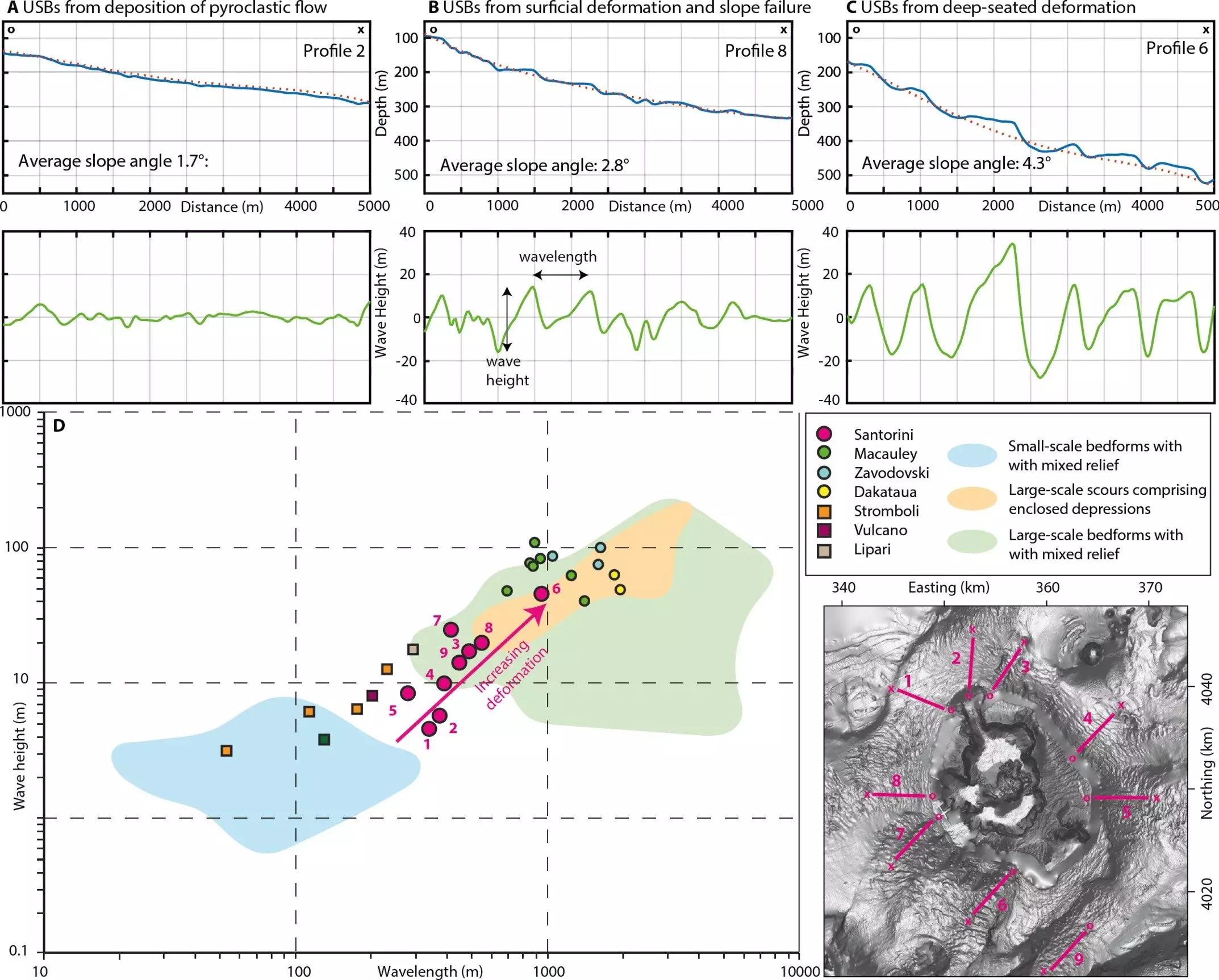The Minoan eruption of Santorini in the Aegean Sea was one of the largest volcanic eruptions in the Holocene. It was a disastrous natural catastrophe that tore apart Santorini and sent large amounts of hot volcanic rock and gas across the eastern Mediterranean. The eruption caused a massive tsunami that devastated the coast of Crete and destroyed many Minoan settlements. Today, only the large caldera rims of the island of Santorini stick out of the sea. Researchers from GEOMAR Helmholtz Centre for Ocean Research Kiel and colleagues from the University of Rhode Island, the University of Hamburg, the Ocean Discovery League, Saunderstown, and the University of Athens studied the marks of this giant cascade of events on the ocean floor to find out what caused the huge tsunami 3,600 years ago.
The Undulating Seafloor Bedforms
In October 2019, a team led by marine geophysicist Dr. Jens Karstens collected new geophysical data with research vessel R/V Poseidon from around the Santorini Caldera. With sound waves, they created a structural image of the subsurface. The researchers combined the new seismic profiles with swath bathymetry data collected during several previous international expeditions. These provide information on the water depth and the detailed morphology of the sea floor. Clearly striking in the high-resolution seismic profiles are wavy sediment structures, so-called undulating seafloor bedforms that can be found radially around the caldera and extend up to 25 kilometers from the volcano. In their study, now published in Earth and Planetary Science Letters, the researchers show that these structures are very important to interpret the genesis of volcanic tsunamis.
Seafloor bedforms are similar to ripples or dunes that one can observe in river beds or at the beach. They develop at the interface of water and the ocean floor because of sediment being transported by flowing water. In the case at Santorini, the sediments were formed when currents of dense hot gas and volcanic rocks, so-called pyroclastic flows, entered the ocean after they flowed at high speeds down the volcanic flanks. Another process that can produce such undulating bedforms is the destabilization of sediments on the volcanic flanks.
The Genesis of Minoan Tsunami
“With the analysis of our new seismic reflection data, we were now able to show that actually the deposits around Santorini are not uniform. They are thicker to the north and thinner at the other flanks,” Karstens says. In the north of Santorini, the undulating seafloor bedforms were formed by pyroclastic flows, and on the other flanks, the researchers see evidence that these sediment structures are related to instabilities of the volcanic flanks, thought to be formed or reactivated during the Minoan Eruption.
The researchers estimate the amount of material that moved down the volcanic flanks during the Minoan eruption to have been two cubic kilometers. In comparison, only one-tenth of the equivalent total volume was displaced during a recent collapse-generated tsunami at Anak Kraktau in 2018, which devastated the surrounding coasts of the Sunda Strait in Indonesia. Triggered by a tremor during the large caldera forming eruption, segments of the volcanic slope slid hundreds of meters down the flank. This caused large water masses to be displaced, generating a huge tsunami wave.
Deformations of the subsurface extending 200 meters deep below the seafloor show that slope instabilities can also be reactivated by regional tectonic earthquakes which have occurred with Magnitudes more than 7 (M7+) in the Santorini area in the past, causing destructive tsunamis.
“This study emphasizes the importance of the understanding of flank instabilities for the tsunami hazard assessment at active volcanoes,” says professor for marine geomechanics at GEOMAR, Dr. Morelia Urlaub, leader of the project PRE COLLAPSE and co-author of the publication. The Minoan eruption is one of the best-studied volcanic eruptions worldwide, and Santorini offers the unique opportunity to relate the formation of the undulating seafloor deposits with the volcanic processes. In August 2023, members of the PRE COLLAPSE research group will visit Anak Krakatau with the research vessel RV Sonne to make similar seismic and bathymetric surveys to study the 1883 and 2018 eruptions. They will be able to use the newly gained knowledge about the undulating seafloor bedforms to better interpret and compare the subsurface structures at Krakatau and Santorini and evaluate how their findings can be applied for hazard assessment also at other active marine volcanoes.



Leave a Reply